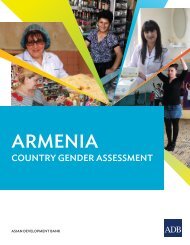Civic Activism as a Novel Component of Armenian Civil Society
English-3
English-3
You also want an ePaper? Increase the reach of your titles
YUMPU automatically turns print PDFs into web optimized ePapers that Google loves.
explore the overall political culture in which new civic initiatives have to operate and to<br />
juxtapose typical characteristics <strong>of</strong> a social media user and a potential activist to determine the<br />
extent to which these two groups overlap.<br />
4.1. Descriptive Analysis <strong>of</strong> the Survey Data<br />
The first part <strong>of</strong> the analysis presents descriptive data on civic and political activism in Armenia,<br />
noting changes over time whenever possible. The purpose is to clarify the overall environment in<br />
which civic activism takes place. We <strong>as</strong>sess the overall culture <strong>of</strong> civic participation by<br />
investigating general public perceptions <strong>of</strong> social movements, membership in various formal and<br />
informal groups and organisations, and volunteering. We then discuss political participation<br />
because civic activism is very <strong>of</strong>ten not the end goal but a tool for bringing change, which is<br />
ultimately a political process, <strong>of</strong>ten aided by political activism. We examine overall interest in<br />
politics and conventional and non-conventional forms <strong>of</strong> political participation, the latter being<br />
the most important since they are <strong>of</strong>ten utilised by civic activists. The third part <strong>of</strong> the descriptive<br />
analysis considers the media landscape and particularly the use <strong>of</strong> social media <strong>as</strong> a source <strong>of</strong><br />
information. The purpose is to <strong>as</strong>sess the potential for outreach using social media, which is<br />
heavily used by <strong>Armenian</strong> civic initiatives to mobilise support and inform the public.<br />
4.1.1. <strong>Civic</strong> Participation and <strong>Civic</strong> <strong>Activism</strong><br />
First, let us consider the overall public attitude towards civic activism. The WVS survey h<strong>as</strong> data<br />
on levels <strong>of</strong> confidence in two types <strong>of</strong> social movements: the environmental movement and the<br />
women’s movement. For both <strong>of</strong> those movements, there are more negative than positive<br />
opinions: in 2011, 31% say they have either a ‘great deal’ or ‘quite a lot’ <strong>of</strong> confidence in<br />
women’s movements, compared with 41% saying either ‘not very much’ or ‘not at all.’ For the<br />
environmental movement, the percentages <strong>of</strong> positive vs. negative responses were 36% and 42%,<br />
respectively. The good news, however, is that WVS data show a clear incre<strong>as</strong>e in confidence in<br />
the women’s movement: the mean, me<strong>as</strong>ured on a scale from 1 (“a great deal”) to 4 (“none at<br />
all”) changed from 3.05 in 1997 to 2.74 in 2011 (note that higher numbers indicate less<br />
confidence, due to the way the responses are coded). Judged by the simple me<strong>as</strong>ure <strong>of</strong> the mean<br />
level <strong>of</strong> confidence, the general public’s perception <strong>of</strong> the environmental movement h<strong>as</strong> not<br />
improved. Nonetheless, when examining the response categories in greater detail, a slight shift in<br />
attitudes is noticeable: fewer people hold strong opinions (either positive or negative), while the<br />
percentage <strong>of</strong> those undecided h<strong>as</strong> incre<strong>as</strong>ed, <strong>as</strong> depicted in Figure 1.<br />
24



